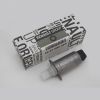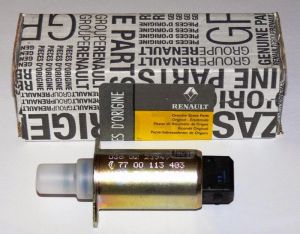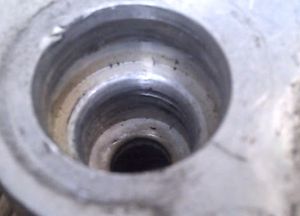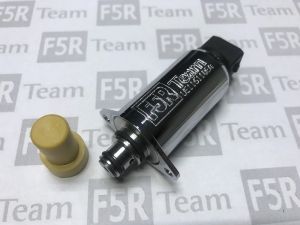Fuel pressure regulator
Fuel pressure regulator
The biggest problem of the engine is the fuel pressure regulator, which is responsible for maintaining the appropriate pressure in the injection rail according to the assumed curve, depending on the engine speed and load. Unfortunately, most regulators have a factory defect, which often caused the regulator to jam, which also resulted in an emergency engine shutdown.
The reason is the use of thermoplastic material, which loses its original properties over time under the influence of high temperature and gasoline. In addition, there is a deposit of fuel depositing on the walls, which with time hinders the movement of the regulator piston (the gap between the piston and the sleeve is 0.05 mm). There are known cases where the regulators were replaced up to six times a year, fortunately under the warranty. In addition, these regulators are available only through authorized Renault services. So far, no replacements for the regulator have appeared. In addition, to have a one-year warranty, you need to set up the regulator in the service.
The regulators can now be regenerated. The regeneration of the regulator extends the mechanical life to approx. 100-150 thousand km. Regulators can also be purchased on the secondary market, but it carries a high risk, because many damaged regulators are sold by people who have acquired new ones, and those coming from disassembly may stop working properly in a moment.
The regulators have the markings 7700113483 (Renault - first assembly) 226706542R (Renault - German production) but they are all interchangeable.
If we decide to buy a new regulator, it must be 226706542R, it is of much better quality than the original 7700113483.
The pressure regulators in the Citroen C5 2.0HPI (EW10D), Opel 2.2 Direct (Z22YH) and Mercedes CGI (2710780289) engines have the same design and the same problem.
Dissasembly and assembly of the regulator
Very important ! The regulator may only be removed when the engine is cold. You should also have a fire extinguisher nearby, just in case. Attempting to remove it while the engine is hot may result in fire. The fuel is under high pressure and temperature of approx. 100 ° C. Unsealing of such a system leads to the immediate boiling of gasoline and its discharge outside, which may cause ignition and explosion of vapors or burns
After unscrewing the two torx screws, turn the valve so that the ear protrudes beyond the edge of the bar. Then, leverage the ear and pull the valve upwards. You should try not to tilt the valve sideways, as you can easily damage the seat in the rail. The assembly consists in pressing it perpendicularly to the socket and tightening it. Do not tilt the regulator sideways as this may result in incorrect positioning of the sealing O-rings. If the regulator seat in the lower part has even a small scratch, it is impossible to obtain tightness.
The original 7x1.5 O-rings are replaced with Fluorine FKM 7.1x1.6. These O-rings are 0.1 mm thicker, which facilitates sealing, but makes assembly difficult. If the o-ring does not want to enter under the pressure of a finger, remove the regulator and check if the seat surface is not damaged. Forcing or hammering in will damage the O-ring. Before putting the O-rings on the regulator, they should be lubricated with grease to facilitate assembly, before inserting the regulator into the socket, it is best to dip the regulator head into engine oil and then push it into the socket, this prevents them from rolling up when pressing. The tightening torque of the regulator screws is 2 Nm.
The tightness of the system is essential for proper engine operation and safety. Therefore, the Renault service procedure does not provide for the disassembly of the regulator itself, but only its replacement with the injection rail. It is caused by the difficulty in obtaining the appropriate tightness of the connection and the possibility of damaging the socket in the strip. Hot gasoline under high pressure has very good penetrating properties and even the smallest gap is not a problem for it. Therefore, all operations are performed at your own risk.
Control of the regulaorem
The pressure regulator is controlled by the PWM power supply from the engine computer. The operating frequency of the power supply is 400Hz. The RCO (PR484) value, i.e. filling, should be 35 +/- 10% during operation, i.e. in the range of 25-45%. The lower the RCO, the better the fuel system is and, in the case of the new high pressure pump and the new regulator, it is even below 25%. After the engine is warmed up, the RCO value increases by a few percent due to the reduction of the magnetic efficiency of the regulator. During start-up, the RCO is 70%.
The value can be measured with a Clip or with most new multimeters with Hz /% function.
Demage to the rail socket
Damaged regulator seat due to tilting sideways during disassembly. An O-ring cannot be inserted into such a socket without damaging it. It is almost impossible to obtain a tightness.
Damage to the O-ring contact surface. The damage is minor, but at idle speed the engine did not maintain sufficient pressure and the injection light came on
Damaged regulator seat due to tilting sideways during disassembly. An O-ring cannot be inserted into such a socket without damaging it. It is almost impossible to obtain a tightness.
Broken valve of the regulator
Regulator F5R
Pressure regulator F5R. It is a regulator with a tungsten carbide valve with a hardness >90ShA, which means that its durability is many times longer than that of the original Renault valves.








